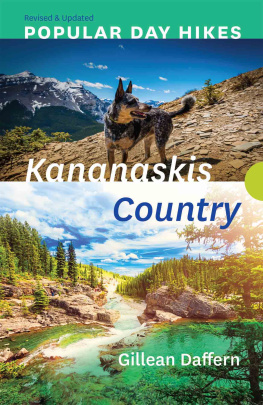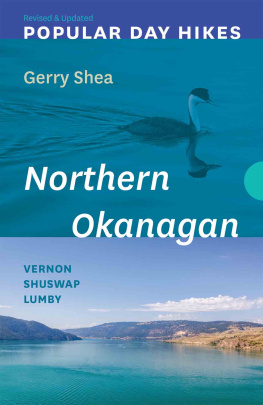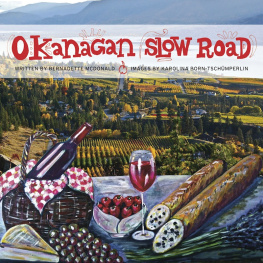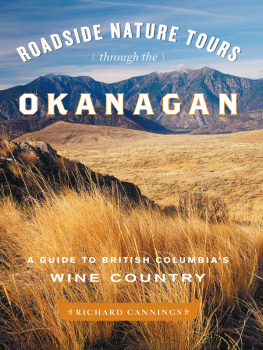Useful Websites
Kelowna Tourism
tourismkelowna.com/do/activities-attractions/hiking
B.C. Parks
env.gov.bc.ca/bcparks
Regional District of Okanagan-Similkameen
Trail Search
www.rdos.bc.ca/index.php?id=140
Acknowledgements
As always, without the support and encouragement of my wife, Debbie, I would still be sitting on the couch, wishing I was outside. Thank you for tolerating my weekend passion, Debbie.
POPULAR DAY HIKES 5
South-Central Okanagan
Kelowna | Penticton | Oliver
GERRY SHEA
Introduction
About the South Okanagan Valley
Stretching north to south in south-central British Columbia, the Okanagan Valley is almost 200 kilometres long, with an average width of 20 kilometres. Lying between the Cascade and Columbia mountain ranges, the South Okanagan Valley extends from Kelowna to Osoyoos, including Peachland, Summerland, Penticton and Oliver. The valley extends well into Washington state. In this region, the Monashee Mountains are the prominent subrange of the Columbia mountain range. Known for its climate, and enjoying consequent popularity as a summer playground, the region contains lakes that are plentiful and large, characterized by an oblong shape, which is generally the result of glacial advancement and retreat.
The soil of the South Okanagan is mainly a mixture of sand, silt and gravel, resulting in fertile land for farming. With the average annual precipitation being only 345 mm, and average summer high temperatures of 27.2C, with 304 days of sunshine, the Okanagan Valley is the richest, most diverse and productive agricultural zone in British Columbia, after the Fraser Valley. Winters are mild, and although snow can fall with ferocity, it doesnt stay for long, so spring in the lowlands of the valley arrives early. This usually allows for a relatively timely start to the hiking season.
Oliver and Osoyoos are the only true desert areas in Canada. All other regions are classified as semi-arid, with sparse forests and open grasslands. The South Okanagan has plenty of hiking and backpacking routes. There are dozens of parks and recreational areas, and just as many provincial parks, providing ample trails with incredible views. The hillsides are rolling mounds with countless ridges and modest peaks. This zone is truly a day hikers dream.
Fruit trees are not native to the Okanagan, although they are one of the most abundant species up and down the valley. Hiram Smith planted the first fruit trees near Osoyoos in the late 1850s. Today, crops include apples, peaches, pears, plums, apricots and cherries. Indigenous forests are comprised mainly of varieties of hemlock and cedar. Intense summer heat combined with dry air readily burns off grasses on open hillsides by late June, leaving cactus and sagebrush to dominate the open hillsides.
Getting there
Highway 97 runs the length of the Okanagan Valley and can be accessed from Vancouver through the winding Crowsnest Highway (Highway 3). The Crowsnest Highway originates at Hope and divides into highways 3 and 3A at the town of Keremeos. Highway 3 reaches Highway 97 at Osoyoos, while Highway 3A intersects with Highway 97 further north at Penticton. Alternatively, take the Coquihalla Highway from Hope to Merritt, veering off the Coquihalla onto Highway 97C. This will also take you to the South Okanagan, arriving at Peachland.
From Calgary, discover the Okanagan Valley by travelling west on the Trans-Canada Highway and turning south at Sicamous onto Highway 97A. From Sicamous, much of the North Okanagan is travelled before reaching Kelowna.
Seasonal road closures
There are no planned seasonal highway closures through the Okanagan Valley, but inclement winter weather can create unscheduled temporary closures.
All gravel Forest Service Roads (FSRs) are subject to late fall, winter and early spring closures, as many of them are not maintained during these times. In the spring runoff period, many FSRs can be closed for several weeks and some can even be washed away altogether. This has never been quite as evident as it became in the spring of 2012 when several gravel and paved roads were washed out and not repaired until mid- to late summer. Refer to the provincial website www.drivebc.ca for updates.
Facilities
Kelowna, Peachland, Summerland, Penticton and Oliver all have full facilities. These include camping with full RV hookups, resorts, hotels, B&Bs and motels. Lakeside accommodation is available in all of these centres for those of you wanting to mix a little decadence with your hiking.
Weather
Summers in the South Okanagan are mild, with hot days, warm nights and low humidity. July and August weather is considered tropical, with temperatures commonly reaching the mid-30s and averaging 27.2C, with 304 days of sunshine annually. Precipitation averages about 345 mm each year.
Winters are mild, with moderate snowfall and average temperatures hovering just above 0C. Cold snaps as low as 25C can last for a couple of weeks at a time, but those are rare.
What does this mean for us day hikers? Despite snowpack runoff from higher elevations into the lowland, the hiking season begins in early spring in many areas. Some trails are snow-free as early as March and April. Summer months are obviously dry and hot, but autumn provides cooler hiking conditions before the snow falls, allowing some late-season trekking.
Drinking water
Although creeks and drainage channels are abundant during spring and early summer, most secondary water sources dry up soon after snowmelt. This creates a scarcity of drinking water during the bulk of hiking season, so bring your days water supply from home, campground or motel. Even during spring runoff, when water is plentiful, bear in mind that this is an agricultural and ranching region, so the water may not be as pure as it appears. Giardia lamblia is the primary parasite that contaminates these waters and it can cause a variety of symptoms including diarrhea, gas or bloating, headache, nausea and a low-grade fever. Even the large lakes contain contaminants, and levels of fecal coliform can be high during the summer months as the shorelines cabins and resorts reach capacity.
Wildlife concerns
The two foremost wildlife concerns in the Okanagan are black bears and cougars, with bears being the more common of the two. Stay alert for bears at all times; there could be one around any corner. Make noise, travel in groups and keep a sharp eye on the trail. Bears come out of hibernation in early spring, looking to fill their empty bellies with as many berries as they can find, so as you enter a clearing or an avalanche slope, look first before going in. The best way to avoid a bear encounter is to avoid a bear encounter. Get out of their way!
Small wildlife can also be bothersome. The hot, dry Okanagan climate is ideal for ticks, and spring is when they are at their peak. Generally, their lifecycle makes them a danger during April, May and June, but the tick season can occur later if spring has been excessively wet. Most ticks in the Okanagan are wood ticks and do not carry Lyme disease bacteria. Check your clothing before getting into your vehicle after a hike so you dont take any of the little critters back home with you. And dont forget to check family pets if theyve been out hiking with you.
Safety tips
Carry bear spray with you at all times, even on short hikes. Bears in the Okanagan are becoming more urbanized as humans encroach on their territory, so they may be closer to a roadside stroll than you might think. It is always a good idea to travel in groups to deter curious bears and for assistance if someone should become injured or ill.










